#biometric access control machine
Explore tagged Tumblr posts
Text
Improve Accuracy and Flexibility with Wireless Attendance Punching Machines
One of the most transformative advancements in workforce management has been the evolution of the attendance punching machine. No longer tethered to physical connections and clunky manual systems, businesses are now leaning toward wireless attendance punching machines for better accuracy, mobility, and operational efficiency.

These advanced systems do more than just mark in and out times—they serve as a foundation for real-time workforce analytics, improve accountability, and eliminate outdated practices that slow down productivity.
What Is a Wireless Attendance Punching Machine?
A wireless attendance punching machine is a digital device that records employees’ clock-in and clock-out times using technologies like Wi-Fi, Bluetooth, mobile data, or cloud connectivity. Unlike traditional systems that rely on local servers and fixed wiring, these machines transmit data wirelessly to cloud-based platforms, enabling HR and management teams to access attendance data in real-time, from anywhere.
Some machines also integrate with biometric recognition (fingerprint, face, or iris scan), RFID cards, or mobile-based authentication methods. This combination significantly reduces the chances of time fraud, such as buddy punching or manual entry errors, and adds a layer of security to attendance tracking.
Why Accuracy Matters in Attendance Management
Workforce efficiency hinges on how accurately time and attendance are recorded. Errors in attendance logs can lead to:
Payroll discrepancies
Disputes with employees
Inaccurate overtime calculation
Compliance issues with labor regulations
By using a wireless attendance punching machine, businesses can automate time tracking with precise timestamps, eliminating manual processes prone to errors. The real-time synchronization with cloud systems ensures that every punch is instantly logged, providing up-to-the-minute data for HR and payroll teams.
Flexibility for Modern Workplaces
Today’s workforce is mobile, remote, and often spread across multiple locations. Traditional attendance systems simply can't keep up with this level of flexibility. Wireless attendance punching machines offer a range of benefits suited for these modern business models:
1. Multi-location Connectivity
Whether your company operates from a single office or multiple branches across the country, wireless machines allow centralized attendance monitoring. Cloud-connected systems ensure all data streams into a unified dashboard, regardless of physical location.
2. Mobile Workforce Support
Field employees, sales personnel, and remote teams can mark attendance using mobile-enabled punching systems equipped with GPS tagging. This helps organizations track attendance accurately even when employees are constantly on the move.
3. Contactless Options
Post-pandemic, businesses are increasingly preferring contactless attendance options. Many wireless systems now support face recognition or mobile app check-ins using Bluetooth or QR codes, ensuring hygienic and secure tracking.
4. Scalability
Wireless systems can easily be scaled as the company grows. Adding new locations, employees, or features can be done without the need for new cabling or heavy infrastructure changes.
Integration with Cloud and Biometric Technology
A major strength of the latest attendance punching machines lies in their ability to integrate seamlessly with biometric systems and cloud-based platforms. Biometric authentication ensures that attendance records are foolproof, while cloud integration allows for real-time access, backups, and data security.
This seamless integration means HR departments can:
Automate attendance summaries and reports
Instantly view absences or late arrivals
Generate reports for payroll and audits
Set custom attendance policies and alerts
Some modern platforms also include analytics features, helping employers spot trends like chronic lateness or absenteeism. These insights can be pivotal in improving workforce efficiency.
How Smart Attendance Solutions Are Transforming Businesses
Adopting a smart attendance punching machine is no longer a luxury—it’s a necessity for organizations looking to modernize. Forward-thinking businesses are already replacing legacy systems with intelligent, cloud-connected platforms that enhance not only attendance management but also access control and overall security.
This is where solutions like the ones offered by companies such as Spintly come into the picture. Without explicitly naming brands, it’s clear that smart access and attendance systems that combine mobile apps, biometric devices, and cloud platforms provide businesses with a competitive edge.
Solutions built on these technologies allow for:
Contactless entry and attendance tracking via smartphones
Real-time monitoring of both attendance and access control events
Data encryption and role-based access to protect sensitive employee information
Customizable workflows for leaves, shift planning, and overtime approvals
Use Cases Across Industries
Wireless attendance punching machines are versatile and can be used across various industries:
Manufacturing & Warehousing – Track shift rotations and attendance in large plants with ease
Healthcare – Ensure compliance with work hours and monitor staffing patterns in real-time
IT and Tech Firms – Support remote and hybrid models with mobile check-ins and centralized data
Education – Monitor staff and even student attendance with biometric and wireless solutions
Hospitality – Handle fluctuating shifts, part-time workers, and distributed teams effortlessly
The Environmental and Economic Edge
Going wireless isn’t just about convenience. By reducing the need for paper records, physical storage, and hardwired infrastructure, wireless attendance systems also contribute to sustainability. They save time, reduce administrative effort, and minimize long-term operational costs—making them an environmentally friendly and economically viable option.
What to Look for When Choosing an Attendance Punching Machine
When selecting a system, businesses should consider:
Connectivity Options: Wi-Fi, 4G, Bluetooth, or all of the above?
Biometric Capabilities: Fingerprint, facial recognition, or iris scan?
Mobile Support: Is there an app for remote attendance or mobile punching?
Integration Potential: Can it connect with payroll, HRMS, or ERP systems?
Cloud-Based Dashboard: Real-time reporting, analytics, and role-based access
Customer Support: Does the provider offer training, setup, and ongoing support?
Solutions that bring together all of these features in a single ecosystem provide the most value and are well-suited for scaling with your business.
Conclusion
In the age of digital transformation, accurate timekeeping is more than a compliance function—it’s a strategic pillar of workforce management. Wireless attendance punching machines offer the precision, flexibility, and insight that growing businesses need to succeed. With the right solution, organizations can streamline attendance tracking, empower their HR teams, and create a secure, data-driven workplace.
If your business is exploring smart attendance and access control technologies, platforms like Spintly offer an integrated, mobile-first approach that blends convenience with smart security. The future of attendance management is wireless—and the time to upgrade is now.
#attendance management#attendance system#biometric attendance#time and attendance software#access control solutions#spintly#mobile access#biometrics#attendance machine#smartbuilding#smartacess#accesscontrol#visitor management system#access control system
0 notes
Text

Biometric Attendance Machine Mumbai
Contact Us Today and Enjoy Up to 10% Off!💥 Get the Best Biometric Attendance Machine for Attendance and access control at Unbeatable Prices! Don't miss out on this limited-time offer! Call Us: 7827942625 Visit:- https://www.securitysolutionindia.in/
#securitysolutionindia#biometric attendance#face recognition#Fingerprintbiometric#todayoffer#ordernow#biometric attendance machine#door lock access control
0 notes
Text
Find the Perfect GPS Tracker System for Your Needs in Gaya
In today's fast-paced world, GPS tracking systems have become an essential tool for both individuals and businesses. Whether you need to keep an eye on your fleet, ensure the safety of loved ones, or manage your assets, finding the right GPS tracker system is crucial. In Gaya, where transportation and logistics play a vital role, choosing the perfect GPS tracker can significantly enhance efficiency and security. This comprehensive guide will help you navigate the options and find the ideal GPS Tracker system In Gaya.
Understanding GPS Tracking Systems
What is a GPS Tracker?
A GPS tracker is a device that uses the Global Positioning System (GPS) to determine and track its precise location. This data is then transmitted to a remote server or device via cellular or satellite networks. GPS trackers are used in a variety of applications, from vehicle tracking to personal safety and asset management.
How Do GPS Trackers Work?
GPS trackers receive signals from a network of satellites orbiting the Earth. These signals contain time and location data, which the tracker uses to calculate its exact position. The device then transmits this information to a central server, where it can be accessed through a web-based platform or a mobile app. This real-time data allows users to monitor the location and movement of the tracker.
Types of GPS Trackers
Vehicle GPS Trackers
Vehicle GPS trackers are designed to be installed in cars, trucks, and other vehicles. Fire Alarm Shop In Gaya They provide real-time tracking, route history, and can even offer insights into driver behavior. These trackers are ideal for fleet management, ensuring that vehicles are used efficiently and safely.
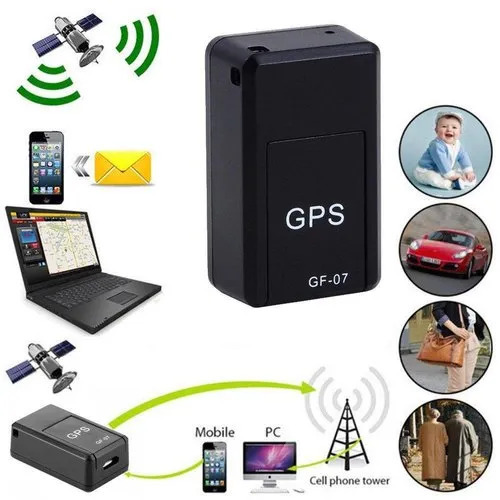
Personal GPS Trackers
Personal GPS trackers are small, portable devices that can be carried by individuals. They are perfect for ensuring the safety of children, elderly family members, or those with special needs. These devices often come with features like emergency SOS buttons and geofencing, which alerts you if the person leaves a designated area.
Asset GPS Trackers
Asset GPS trackers are used to monitor valuable items, such as machinery, equipment, and cargo. These trackers help prevent theft and ensure that assets are used properly. They can be attached to almost anything, providing peace of mind and security.
Key Features to Look for in a GPS Tracker
Real-Time Tracking
One of the most crucial features of a GPS tracker is real-time tracking. Electronics Security And Surveillance In Gaya This allows you to see the exact location of the tracker at any given moment. Real-time tracking is essential for applications like fleet management, where knowing the precise location of each vehicle is vital.
Geofencing
Geofencing is a feature that lets you set virtual boundaries around a specific area. If the tracker enters or leaves this area, you receive an alert. This is particularly useful for personal trackers, ensuring that children or elderly family members stay within safe zones.
Battery Life
Battery life is a critical consideration when choosing a GPS tracker. Look for devices with long-lasting batteries, especially if you need continuous tracking over extended periods. Some trackers come with rechargeable batteries, while others use replaceable ones.
Durability and Waterproofing
For outdoor and rugged use, ensure that the GPS tracker is durable and waterproof. Electronic Security And Surveillance in Bihar This ensures the device can withstand harsh conditions and continue to function reliably.
Data Storage and History
Access to historical data can be extremely beneficial. Look for trackers that offer data storage and the ability to review past locations and movements. This feature is useful for analyzing routes and identifying patterns.
Top GPS Trackers Available in Gaya
TrakkingPro VT1000
The TrakkingPro VT1000 is a versatile vehicle GPS tracker ideal for fleet management. It offers real-time tracking, driver behavior monitoring, and route optimization. Its robust design ensures durability, and it comes with a user-friendly mobile app for easy access.
SafeGuard Mini GPS Tracker
The SafeGuard Mini GPS Tracker is perfect for personal use. Its compact size and long battery life make it ideal for keeping track of children or elderly family members. It features an SOS button, geofencing, and real-time tracking, ensuring safety and peace of mind.
AssetGuard AG300
The AssetGuard AG300 is designed for asset tracking. It’s rugged, waterproof, and provides real-time location data. Epabx and Intercom Store In Gaya This tracker is excellent for securing valuable assets like machinery and equipment. Its long battery life ensures continuous monitoring.
How to Choose the Right GPS Tracker
Assess Your Needs
Before choosing a GPS tracker, assess your specific needs. Are you looking for a device to track vehicles, individuals, or assets? Understanding your requirements will help you narrow down the options and select the most suitable tracker.
Consider the Coverage Area
Ensure that the GPS tracker you choose has reliable coverage in Gaya. Some trackers use cellular networks, while others rely on satellite communication. Choose a tracker that offers consistent coverage in your area of operation.
Check Reviews and Ratings
Research and read reviews of different GPS trackers. Look for devices with high ratings and positive feedback from users. This will give you an idea of the tracker’s performance and reliability.
Evaluate the Cost
Consider your budget when choosing a GPS tracker. CCTV Camera Store in Gaya While it’s important to find an affordable option, don’t compromise on essential features. Evaluate the cost of the device, subscription fees, and any additional charges.
Installation and Setup
Professional Installation vs. DIY
Some GPS trackers require professional installation, especially those designed for vehicles. Professional installation ensures that the device is correctly set up and functions properly. However, many personal and asset trackers are easy to install and can be set up by the user.
Setting Up Alerts and Notifications
Once your GPS tracker is installed, set up alerts and notifications based on your needs. This could include geofencing alerts, low battery warnings, or movement notifications. Properly configuring these settings ensures that you receive timely updates.
Maximizing the Benefits of GPS Tracking
Improving Fleet Management
For businesses in Gaya, using Camera Store In Gaya for fleet management can lead to significant improvements in efficiency and productivity. Trackers provide real-time data on vehicle locations, helping optimize routes, reduce fuel consumption, and enhance customer service.
Ensuring Personal Safety
Personal GPS trackers are invaluable for ensuring the safety of loved ones. Whether it’s keeping track of children on their way to school or monitoring elderly family members, these devices provide peace of mind and swift response in emergencies.
Securing Valuable Assets
For businesses and individuals with valuable assets, GPS trackers offer robust security solutions. Trackers help prevent theft, monitor usage, and provide real-time location data, ensuring that assets are always under surveillance.
Choosing the perfect GPS tracker system for your needs in Gaya involves careful consideration of your requirements, the features offered by different trackers, and their performance. Whether you need to manage a fleet, ensure personal safety, or secure valuable assets, a reliable GPS tracker can make a significant difference. By understanding the options and selecting a device that meets your specific needs, you can enhance efficiency, security, and peace of mind.
#GPS Tracker system In Gaya#Fire Alarm Shop In Gaya#Currency Counting Machine Shop In Gaya#Automatic School bell Store In Gaya#Epabx and Intercom Store In Gaya#Video Door Phone Store In Gaya#Fire Extinguisher Store In Gaya#Biometric Attendance and Access control In Gaya#Camera Store In Gaya#CCTV Camera Store in Gaya
0 notes
Text
The Advantages of Using VivencyGlobal’s Surveillance Solutions
Vivency Global is a leading provider of surveillance solutions that help organizations protect their assets, people, and operations. With over a decade of experience in designing, implementing, and managing complex security systems, Vivency Global has a proven track record of delivering high-quality solutions that meet the diverse needs of its clients. In this blog post, we will explore some of the advantages of using VivencyGlobal’s surveillance solutions and how they can benefit your business.
Comprehensive coverage
VivencyGlobal’s surveillance solutions offer comprehensive coverage of your premises, both indoors and outdoors. They use advanced technologies such as high-definition cameras, thermal imaging, facial recognition, license plate recognition, and analytics to detect and deter potential threats, identify suspicious behavior, and provide actionable intelligence to your security team. Whether you need to monitor your office building, warehouse, parking lot, or retail store, Vivency Global can design a customized solution that fits your needs and budget.
Real-time monitoring
VivencyGlobal’s surveillance solutions enable real-time monitoring of your premises from any location, using any device with an internet connection. This means you can stay connected to your security system 24/7 and receive alerts and notifications in case of any security breaches, unauthorized access, or other abnormal activities. You can also review live and recorded footage, manage access control, and communicate with your security team or law enforcement agencies using the same platform.
Scalability and flexibility
VivencyGlobal’s surveillance solutions are scalable and flexible, meaning they can adapt to your changing security requirements as your business grows or evolves. Whether you need to add more cameras, upgrade your software, integrate with other systems, or migrate to a cloud-based platform, Vivency Global can provide you with a seamless and cost-effective solution that minimizes disruption and maximizes value.
Expertise and support
VivencyGlobal’s surveillance solutions are backed by a team of experienced security professionals who understand the latest trends, technologies, and regulations in the industry. They can provide you with expert advice, training, and support throughout the lifecycle of your security system, from design to deployment to maintenance. They can also help you optimize your system’s performance, reduce false alarms, and minimize downtime, ensuring that your security system operates at peak efficiency.
Compliance and privacy
VivencyGlobal’s surveillance solutions are designed to comply with the highest standards of privacy and data protection. They use encryption, authentication, and access control mechanisms to secure your data and prevent unauthorized access, disclosure, or modification. They also adhere to local and international regulations such as GDPR, HIPAA, PCI-DSS, and SOX, ensuring that your security system meets the legal and ethical requirements of your industry and jurisdiction.
In conclusion, VivencyGlobal’s surveillance solutions offer many advantages that can help you enhance your security posture, reduce your risk exposure, and improve your operational efficiency. Whether you need to prevent theft, vandalism, or violence, or monitor compliance, productivity, or customer experience, Vivency Global can provide you with a customized solution that meets your needs and exceeds your expectations. To learn more about VivencyGlobal’s surveillance solutions, contact us today.
#Surveillance#Security#Monitoring#CCTV#Privacy#Technology#Data collection#Intelligence#Video analytics#Remote monitoring#Access control#Intrusion detection#Biometrics#Facial recognition#Network security#Smart cameras#Privacy concerns#Threat detection#Cybersecurity#Artificial intelligence (AI)#Machine learning#Sensor networks#Crime prevention#Homeland security#Public safety
1 note
·
View note
Text
ZKTeco iFace880 Plus Multi Biometric Time Attendance
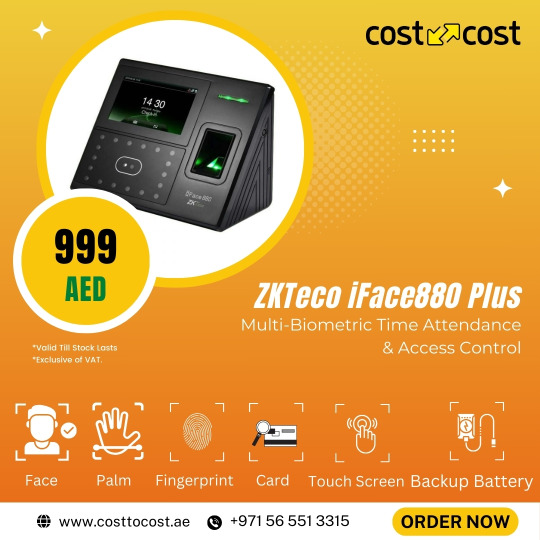
ZKTeco presents the iFace880 Plus multi-biometric time attendance and access control terminal which supports 3,000 palm templates, 4,000 fingerprint templates, and 10,000 cards (optional).
It is equipped with ZKTeco’s latest hardware platform and algorithm like 3-in-1 contactless palm recognition (palm shape, palm print, and palm vein).
This makes the terminal perform bio-authentication with the palm vein, palm print, and the shape of the palm when the sensor detects a hand that is presented.
The terminal’s touchless palm authentication method with a novel hand tracking technique allows angle tolerance as wide as +/- 60° in the roll axis.
With the advanced palm and face algorithm and multi-biometric verification technology, users can experience the terminal’s enhanced anti-spoofing ability and its significantly improved security level.
Features of ZKTeco iFace880 Plus
• 3,000 face, 3,000 palm, and 4,000 fingerprint templates • Multiple authentication methods: face/palm/fingerprint/card/password • Fast verification speed • Modern design and interactive UI • Chip encryption for firmware protection • Optional built-in backup battery providing approximately 4 hours of continuous operation
ZKTeco iFace880 Plus price in UAE
Cost To Cost provides the best price for the ZKTeco iFace880 access control
#zk#zkteco#dubai#uae#business#it support#time attendance machine#fingerprint time attendance and access control#access control systems#time attendance#biometric time attendance#ZKTeco iFace880 plus#costtocost#sharjah#biometric attendance system#fingerprint recognition
0 notes
Text
Why Biometric & Time Attendance Systems Matter
Time is money, and effective time management is essential for businesses to thrive. Traditional punch cards and paper registers have become obsolete and ineffective in modern workplaces. Biometric and time attendance systems have emerged as game-changers for businesses by offering the following benefits:
Accuracy: Biometric systems use unique human characteristics such as fingerprints, facial recognition, or iris scans, ensuring that employees cannot clock in or out for each other. This accuracy reduces payroll errors and saves money.
Elimination of Buddy Punching: With biometric systems, employees cannot clock in or out for their absent colleagues, preventing fraudulent practices and ensuring fair work hours.
Real-time Monitoring: Employers can monitor attendance in real time, providing instant insights into employee attendance patterns and helping with workforce planning.
Security: Biometric data is highly secure, reducing the risk of unauthorized access to sensitive areas within the organization.
Convenience: Employees can clock in and out quickly and conveniently, without the hassle of remembering passwords or carrying physical cards.
Tektronix Technologies: A Pioneer in Biometric & Time Attendance Systems
Tektronix Technologies has established itself as a trusted name in the field of biometric and time attendance systems in Dubai and Abu Dhabi. Here's why they are a preferred choice:
Cutting-Edge Technology: Tektronix Technologies stays at the forefront of technological advancements. Their systems utilize the latest biometric recognition methods, ensuring the highest level of accuracy and security.
Customized Solutions: They offer tailored solutions that fit the unique needs of each business, whether it's a small startup or a large enterprise.
User-Friendly Interfaces: Tektronix Technologies designs user-friendly interfaces that are easy to use for both employees and administrators.
Scalability: Their systems are scalable, meaning they can grow with your business, accommodating additional employees and locations.
Local Support: With a strong presence in Dubai and Abu Dhabi, Tektronix Technologies provides local support and maintenance, ensuring that your system runs smoothly at all times.
In a competitive business environment like Dubai and Abu Dhabi, efficient time and attendance management is critical for success. Tektronix Technologies offers cutting-edge biometric and time attendance systems that not only streamline attendance tracking but also enhance security and accuracy. Investing in these advanced systems is a strategic move that can lead to significant cost savings, improved productivity, and greater peace of mind for business owners and managers. With Tektronix Technologies, businesses in these dynamic cities are empowered to manage their workforce efficiently and effectively, paving the way for growth and success in the modern business landscape.
time attendance system dubai
time attendance system abu dhabi
biometric access control system
biometric access control system dubai
biometric access control system UAE
biometric access control system bur dubai
biometric access control system alain
biometric access control system
time attendance machine
time attendance machine Dubai
time attendance machine Abu Dhabi
time attendance machine uae
#timeattendancesystemabudhabi #timeattendancesystemdubai #timeattendancesystemabudhabi #timeattendancemachineuae #biometricmachinesupplierindubai #biometricmachinesupplierinuae #biometricaccesscontrolsystem #timeattendancemachineuae
#timeattendancesystemsoftware #imeattendancesystemsoftwareuae #timeattendancesystemsoftwaredubai
#timeattendancesystemsoftwareburdubai #fingerprintattendancesystemsoftwareuae
#biometric access control system#biometric access control system dubai#biometric access control system abu dhabi#biometric access control system in uae#biometric access control system in ajman#bio metric access control system in bur dubai#bio metric access control saudi arabia#time attendance system#time attendance system dubai#time attendance system uae#time attendance system abu dhabi#time attendance system in bur dubai#time attendance system in alain#time attendance system bur dubai#time attendance system in ajman#time attendance system sharjah#time attendance system dubai in alain#time attendance machine abu dhabi#time attendance solutions in bur dubai#time attendance machine in uae#time attendance machine in bur dubai#time attendance in bur dubai#time attendance bur dubai#time attendance machine in bur Dubai#biometric attendance machine uae#biometric attendance machine abu dhabi#biometric attendance machine in uae#biometric attendance machine bur dubai#biometric attendance machine in ajman#biometric attendance machine sharjah
0 notes
Text
#biometrics#biometric macine#Biometric Machine Company#Biometric System and Access Control Machine#Fingerprint Attendance System#Biometric Attendance System
0 notes
Text
time attendance system
timevision one of the leading biometric time attendance system Dubai supplier and installation company. Time Attendance System Dubai – we provide excellent and world leading time attendance machine in your requirements. time attendance device easily capture every employee in and out time with fingerprint and face id authentications. you can easily calculate total employee attendance report with in second. time attendance device used to improve your office working hours and employee potential energy. and increase your office revenues. biometric time attendance machines are prevent duplicate fingerprint and face id. biometric time attendance system widely used all industry. Easily manage time attendance system. timevision provide online time attendance management system & attendance tracking software in Dubai to help manage attendance report remotely. out IT-team developed new time attendance reporting software
time attendance system Dubai
Bio metric time attendance system helped to manage the employee’s attendance, monthly and yearly leaves, employees’ progress reports and employee’s daily records. To check in and out time for pay role process . Importance of time attendance system is to monitor employee time activity. Do you remember the old fashioned days, employee’s in and out time is manually it become chaotic and manipulated easily .
Timevision security system developed timesuite biometric time attendance system software. These software used to manage the employee’s attendance and go to modern level managing time attendance system. We provide lot of specification and feature in this software. This software especially made for Biometric time attendance reporting system. continue reading
#time attendance#time attendance system#time attendance supplier#biometric attendance punching machine#fingerprint attendance punching machine#rfid card#time attendance installation company#UAE#Dubai#cctv camera#door access control#door access control installation company#gate barrier#barrier gate system
1 note
·
View note
Text
Scan the online brochures of companies who sell workplace monitoring tech and you’d think the average American worker was a renegade poised to take their employer down at the next opportunity. “Nearly half of US employees admit to time theft!” “Biometric readers for enhanced accuracy!” “Offer staff benefits in a controlled way with Vending Machine Access!”
A new wave of return-to-office mandates has arrived since the New Year, including at JP Morgan Chase, leading advertising agency WPP, and Amazon—not to mention President Trump’s late January directive to the heads of federal agencies to “terminate remote work arrangements and require employees to return to work in-person … on a full-time basis.” Five years on from the pandemic, when the world showed how effectively many roles could be performed remotely or flexibly, what’s caused the sudden change of heart?
“There’s two things happening,” says global industry analyst Josh Bersin, who is based in California. “The economy is actually slowing down, so companies are hiring less. So there is a trend toward productivity in general, and then AI has forced virtually every company to reallocate resources toward AI projects.
“The expectation amongst CEOs is that’s going to eliminate a lot of jobs. A lot of these back-to-work mandates are due to frustration that both of those initiatives are hard to measure or hard to do when we don’t know what people are doing at home.”
The question is, what exactly are we returning to?
Take any consumer tech buzzword of the 21st century and chances are it’s already being widely used across the US to monitor time, attendance and, in some cases, the productivity of workers, in sectors such as manufacturing, retail, and fast food chains: RFID badges, GPS time clock apps, NFC apps, QR code clocking-in, Apple Watch badges, and palm, face, eye, voice, and finger scanners. Biometric scanners have long been sold to companies as a way to avoid hourly workers “buddy punching” for each other at the start and end of shifts—so-called “time theft.” A return-to-office mandate and its enforcement opens the door for similar scenarios for salaried staff.
Track and Trace
The latest, deluxe end point of these time and attendance tchotchkes and apps is something like Austin-headquartered HID’s OmniKey platform. Designed for factories, hospitals, universities and offices, this is essentially an all-encompassing RFID log-in and security system for employees, via smart cards, smartphone wallets, and wearables. These will not only monitor turnstile entrances, exits, and floor access by way of elevators but also parking, the use of meeting rooms, the cafeteria, printers, lockers, and yes, vending machine access.
These technologies, and more sophisticated worker location- and behavior-tracking systems, are expanding from blue-collar jobs to pink-collar industries and even white-collar office settings. Depending on the survey, approximately 70 to 80 percent of large US employers now use some form of employee monitoring, and the likes of PwC have explicitly told workers that managers will be tracking their location to enforce a three-day office week policy.
“Several of these earlier technologies, like RFID sensors and low-tech barcode scanners, have been used in manufacturing, in warehouses, or in other settings for some time,” says Wolfie Christl, a researcher of workplace surveillance for Cracked Labs, a nonprofit based in Vienna, Austria. “We’re moving toward the use of all kinds of sensor data, and this kind of technology is certainly now moving into the offices. However, I think for many of these, it’s questionable whether they really make sense there.”
What’s new, at least to the recent pandemic age of hybrid working, is the extent to which workers can now be tracked inside office buildings. Cracked Labs published a frankly terrifying 25-page case study report in November 2024 showing how systems of wireless networking, motion sensors, and Bluetooth beacons, whether intentionally or as a byproduct of their capabilities, can provide “behavioral monitoring and profiling” in office settings.
The project breaks the tech down into two categories: The first is technology that tracks desk presence and room occupancy, and the second monitors the indoor location, movement, and behavior of the people working inside the building.
To start with desk and room occupancy, Spacewell offers a mix of motion sensors installed under desks, in ceilings, and at doorways in “office spaces” and heat sensors and low-resolution visual sensors to show which desks and rooms are being used. Both real-time and trend data are available to managers via its “live data floorplan,” and the sensors also capture temperature, environmental, light intensity, and humidity data.
The Swiss-headquartered Locatee, meanwhile, uses existing badge and device data via Wi-Fi and LAN to continuously monitor clocking in and clocking out, time spent by workers at desks and on specific floors, and the number of hours and days spent by employees at the office per week. While the software displays aggregate rather than individual personal employee data to company executives, the Cracked Labs report points out that Locatee offers a segmented team analytics report which “reveals data on small groups.”
As more companies return to the office, the interest in this idea of “optimized” working spaces is growing fast. According to S&S Insider’s early 2025 analysis, the connected office was worth $43 billion in 2023 and will grow to $122.5 billion by 2032. Alongside this, IndustryARC predicts there will be a $4.5 billion employee-monitoring-technology market, mostly in North America, by 2026—the only issue being that the crossover between the two is blurry at best.
At the end of January, Logitech showed off its millimeter-wave radar Spot sensors, which are designed to allow employers to monitor whether rooms are being used and which rooms in the building are used the most. A Logitech rep told The Verge that the peel-and-stick devices, which also monitor VOCs, temperature, and humidity, could theoretically estimate the general placement of people in a meeting room.
As Christl explains, because of the functionality that these types of sensor-based systems offer, there is the very real possibility of a creep from legitimate applications, such as managing energy use, worker health and safety, and ensuring sufficient office resources into more intrusive purposes.
“For me, the main issue is that if companies use highly sensitive data like tracking the location of employees’ devices and smartphones indoors or even use motion detectors indoors,” he says, “then there must be totally reliable safeguards that this data is not being used for any other purposes.”
Big Brother Is Watching
This warning becomes even more pressing where workers’ indoor location, movement, and behavior are concerned. Cisco’s Spaces cloud platform has digitized 11 billion square feet of enterprise locations, producing 24.7 trillion location data points. The Spaces system is used by more than 8,800 businesses worldwide and is deployed by the likes of InterContinental Hotels Group, WeWork, the NHS Foundation, and San Jose State University, according to Cisco’s website.
While it has applications for retailers, restaurants, hotels, and event venues, many of its features are designed to function in office environments, including meeting room management and occupancy monitoring. Spaces is designed as a comprehensive, all-seeing eye into how employees (and customers and visitors, depending on the setting) and their connected devices, equipment, or “assets” move through physical spaces.
Cisco has achieved this by using its existing wireless infrastructure and combining data from Wi-Fi access points with Bluetooth tracking. Spaces offers employers both real-time views and historical data dashboards. The use cases? Everything from meeting-room scheduling and optimizing cleaning schedules to more invasive dashboards on employees’ entry and exit times, the duration of staff workdays, visit durations by floor, and other “behavior metrics.” This includes those related to performance, a feature pitched at manufacturing sites.
Some of these analytics use aggregate data, but Cracked Labs details how Spaces goes beyond this into personal data, with device usernames and identifiers that make it possible to single out individuals. While the ability to protect privacy by using MAC randomization is there, Cisco emphasizes that this makes indoor movement analytics “unreliable” and other applications impossible—leaving companies to make that decision themselves.
Management even has the ability to send employees nudge-style alerts based on their location in the building. An IBM application, based on Cisco’s underlying technology, offers to spot anomalies in occupancy patterns and send notifications to workers or their managers based on what it finds. Cisco’s Spaces can also incorporate video footage from Cisco security cameras and WebEx video conferencing hardware into the overall system of indoor movement monitoring; another example of function creep from security to employee tracking in the workplace.
“Cisco is simply everywhere. As soon as employers start to repurpose data that is being collected from networking or IT infrastructure, this quickly becomes very dangerous, from my perspective.” says Christl. “With this kind of indoor location tracking technology based on its Wi-Fi networks, I think that a vendor as major as Cisco has a responsibility to ensure it doesn’t suggest or market solutions that are really irresponsible to employers.
“I would consider any productivity and performance tracking very problematic when based on this kind of intrusive behavioral data.” WIRED approached Cisco for comment but didn’t receive a response before publication.
Cisco isn't alone in this, though. Similar to Spaces, Juniper’s Mist offers an indoor tracking system that uses both Wi-Fi networks and Bluetooth beacons to locate people, connected devices, and Bluetooth tagged badges on a real-time map, with the option of up to 13 months of historical data on worker behavior.
Juniper’s offering, for workplaces including offices, hospitals, manufacturing sites, and retailers, is so precise that it is able to provide records of employees’ device names, together with the exact enter and exit times and duration of visits between “zones” in offices—including one labeled “break area/kitchen” in a demo. Yikes.
For each of these systems, a range of different applications is functionally possible, and some which raise labor-law concerns. “A worst-case scenario would be that management wants to fire someone and then starts looking into historical records trying to find some misconduct,” says Christl. "If it’s necessary to investigate employees, then there should be a procedure where, for example, a worker representative is looking into the fine-grained behavioral data together with management. This would be another safeguard to prevent misuse.”
Above and Beyond?
If warehouse-style tracking has the potential for management overkill in office settings, it makes even less sense in service and health care jobs, and American unions are now pushing for more access to data and quotas used in disciplinary action. Elizabeth Anderson, professor of public philosophy at the University of Michigan and the author of Private Government: How Employers Rule Our Lives, describes how black-box algorithm-driven management and monitoring affects not just the day-to-day of nursing staff but also their sense of work and value.
“Surveillance and this idea of time theft, it’s all connected to this idea of wasting time,” she explains. “Essentially all relational work is considered inefficient. In a memory care unit, for example, the system will say how long to give a patient breakfast, how many minutes to get them dressed, and so forth.
“Maybe an Alzheimer’s patient is frightened, so a nurse has to spend some time calming them down, or perhaps they have lost some ability overnight. That’s not one of the discrete physical tasks that can be measured. Most of the job is helping that person cope with declining faculties; it takes time for that, for people to read your emotions and respond appropriately. What you get is massive moral injury with this notion of efficiency.”
This kind of monitoring extends to service workers, including servers in restaurants and cleaning staff, according to a 2023 Cracked Labs’ report into retail and hospitality. Software developed by Oracle is used to, among other applications, rate and rank servers based on speed, sales, timekeeping around breaks, and how many tips they receive. Similar Oracle software that monitors mobile workers such as housekeepers and cleaners in hotels uses a timer for app-based micromanagement—for instance, “you have two minutes for this room, and there are four tasks.”
As Christl explains, this simply doesn’t work in practice. “People have to struggle to combine what they really do with this kind of rigid, digital system. And it’s not easy to standardize work like talking to patients and other kinds of affective work, like how friendly you are as a waiter. This is a major problem. These systems cannot represent the work that is being done accurately.”
But can knowledge work done in offices ever be effectively measured and assessed either? In an episode of his podcast in January, host Ezra Klein battled his own feelings about having many of his best creative ideas at a café down the street from where he lives rather than in The New York Times’ Manhattan offices. Anderson agrees that creativity often has to find its own path.
“Say there’s a webcam tracking your eyes to make sure you’re looking at the screen,” she says. “We know that daydreaming a little can actually help people come up with creative ideas. Just letting your mind wander is incredibly useful for productivity overall, but that requires some time looking around or out the window. The software connected to your camera is saying you’re off-duty—that you’re wasting time. Nobody’s mind can keep concentrated for the whole work day, but you don’t even want that from a productivity point of view.”
Even for roles where it might make more methodological sense to track discrete physical tasks, there can be negative consequences of nonstop monitoring. Anderson points to a scene in Erik Gandini’s 2023 documentary After Work that shows an Amazon delivery driver who is monitored, via camera, for their driving, delivery quotas, and even getting dinged for using Spotify in the van.
“It’s very tightly regulated and super, super intrusive, and it’s all based on distrust as the starting point,” she says. “What these tech bros don’t understand is that if you install surveillance technology, which is all about distrusting the workers, there is a deep feature of human psychology that is reciprocity. If you don’t trust me, I’m not going to trust you. You think an employee who doesn’t trust the boss is going to be working with the same enthusiasm? I don’t think so.”
Trust Issues
The fixes, then, might be in the leadership itself, not more data dashboards. “Our research shows that excessive monitoring in the workplace can damage trust, have a negative impact on morale, and cause stress and anxiety,” says Hayfa Mohdzaini, senior policy and practice adviser for technology at the CIPD, the UK’s professional body for HR, learning, and development. “Employers might achieve better productivity by investing in line manager training and ensuring employees feel supported with reasonable expectations around office attendance and manageable workloads.”
A 2023 Pew Research study found that 56 percent of US workers were opposed to the use of AI to keep track of when employees were at their desks, and 61 percent were against tracking employees’ movements while they work.
This dropped to just 51 percent of workers who were opposed to recording work done on company computers, through the use of a kind of corporate “spyware” often accepted by staff in the private sector. As Josh Bersin puts it, “Yes, the company can read your emails” with platforms such as Teramind, even including “sentiment analysis” of employee messages.
Snooping on files, emails, and digital chats takes on new significance when it comes to government workers, though. New reporting from WIRED, based on conversations with employees at 13 federal agencies, reveals the extent to Elon Musk’s DOGE team’s surveillance: software including Google’s Gemini AI chatbot, a Dynatrace extension, and security tool Splunk have been added to government computers in recent weeks, and some people have felt they can’t speak freely on recorded and transcribed Microsoft Teams calls. Various agencies already use Everfox software and Dtex’s Intercept system, which generates individual risk scores for workers based on websites and files accessed.
Alongside mass layoffs and furloughs over the past four weeks, the so-called Department of Government Efficiency has also, according to CBS News and NPR reports, gone into multiple agencies in February with the theater and bombast of full X-ray security screenings replacing entry badges at Washington, DC, headquarters. That’s alongside managers telling staff that their logging in and out of devices, swiping in and out of workspaces, and all of their digital work chats will be “closely monitored” going forward.
“Maybe they’re trying to make a big deal out of it to scare people right now,” says Bersin. “The federal government is using back-to-work as an excuse to lay off a bunch of people.”
DOGE staff have reportedly even added keylogger software to government computers to track everything employees type, with staff concerned that anyone using keywords related to progressive thinking or "disloyalty” to Trump could be targeted—not to mention the security risks it introduces for those working on sensitive projects. As one worker told NPR, it feels “Soviet-style” and “Orwellian” with “nonstop monitoring.” Anderson describes the overall DOGE playbook as a series of “deeply intrusive invasions of privacy.”
Alternate Realities
But what protections are out there for employees? Certain states, such as New York and Illinois, do offer strong privacy protections against, for example, unnecessary biometric tracking in the private sector, and California’s Consumer Privacy Act covers workers as well as consumers. Overall, though, the lack of federal-level labor law in this area makes the US something of an alternate reality to what is legal in the UK and Europe.
The Electronic Communications Privacy Act in the US allows employee monitoring for legitimate business reasons and with the worker’s consent. In Europe, Algorithm Watch has made country analyses for workplace surveillance in the UK, Italy, Sweden, and Poland. To take one high-profile example of the stark difference: In early 2024, Serco was ordered by the UK's privacy watchdog, the Information Commissioner’s Office (ICO), to stop using face recognition and fingerprint scanning systems, designed by Shopworks, to track the time and attendance of 2,000 staff across 38 leisure centers around the country. This new guidance led to more companies reviewing or cutting the technology altogether, including Virgin Active, which pulled similar biometric employee monitoring systems from 30-plus sites.
Despite a lack of comprehensive privacy rights in the US, though, worker protest, union organizing, and media coverage can provide a firewall against some office surveillance schemes. Unions such as the Service Employees International Union are pushing for laws to protect workers from black-box algorithms dictating the pace of output.
In December, Boeing scrapped a pilot of employee monitoring at offices in Missouri and Washington, which was based on a system of infrared motion sensors and VuSensor cameras installed in ceilings, made by Ohio-based Avuity. The U-turn came after a Boeing employee leaked an internal PowerPoint presentation on the occupancy- and headcount-tracking technology to The Seattle Times. In a matter of weeks, Boeing confirmed that managers would remove all the sensors that had been installed to date.
Under-desk sensors, in particular, have received high-profile backlash, perhaps because they are such an obvious piece of surveillance hardware rather than simply software designed to record work done on company machines. In the fall of 2022, students at Northeastern University hacked and removed under-desk sensors produced by EnOcean, offering “presence detection” and “people counting,” that had been installed in the school’s Interdisciplinary Science & Engineering Complex. The university provost eventually informed students that the department had planned to use the sensors with the Spaceti platform to optimize desk usage.
OccupEye (now owned by FM: Systems), another type of under-desk heat and motion sensor, received a similar reaction from staff at Barclays Bank and The Telegraph newspaper in London, with employees protesting and, in some cases, physically removing the devices that tracked the time they spent away from their desks.
Despite the fallout, Barclays later faced a $1.1 billion fine from the ICO when it was found to have deployed Sapience’s employee monitoring software in its offices, with the ability to single out and track individual employees. Perhaps unsurprisingly in the current climate, that same software company now offers “lightweight device-level technology” to monitor return-to-office policy compliance, with a dashboard breaking employee location down by office versus remote for specific departments and teams.
According to Elizabeth Anderson’s latest book Hijacked, while workplace surveillance culture and the obsession with measuring employee efficiency might feel relatively new, it can actually be traced back to the invention of the “work ethic” by the Puritans in the 16th and 17th centuries.
“They thought you should be working super hard; you shouldn’t be idling around when you should be in work,” she says. “You can see some elements there that can be developed into a pretty hostile stance toward workers. The Puritans were obsessed with not wasting time. It was about gaining assurance of salvation through your behavior. With the Industrial Revolution, the ‘no wasting time’ became a profit-maximizing strategy. Now you’re at work 24/7 because they can get you on email.”
Some key components of the original work ethic, though, have been skewed or lost over time. The Puritans also had strict constraints on what duties employers had toward their workers: paying a living wage and providing safe and healthy working conditions.
“You couldn’t just rule them tyrannically, or so they said. You had to treat them as your fellow Christians, with dignity and respect. In many ways the original work ethic was an ethic which uplifted workers.”
6 notes
·
View notes
Text
How AI & Machine Learning Are Changing UI/UX Design

Artificial Intelligence (AI) and Machine Learning (ML) are revolutionizing UI/UX design by making digital experiences more intelligent, adaptive, and user-centric. From personalized interfaces to automated design processes, AI is reshaping how designers create and enhance user experiences. In this blog, we explore the key ways AI and ML are transforming UI/UX design and what the future holds.
For more UI/UX trends and insights, visit Pixelizes Blog.
AI-Driven Personalization
One of the biggest changes AI has brought to UI/UX design is hyper-personalization. By analyzing user behavior, AI can tailor content, recommendations, and layouts to individual preferences, creating a more engaging experience.
How It Works:
AI analyzes user interactions, including clicks, time spent, and preferences.
Dynamic UI adjustments ensure users see what’s most relevant to them.
Personalized recommendations, like Netflix suggesting shows or e-commerce platforms curating product lists.
Smart Chatbots & Conversational UI
AI-powered chatbots have revolutionized customer interactions by offering real-time, intelligent responses. They enhance UX by providing 24/7 support, answering FAQs, and guiding users seamlessly through applications or websites.
Examples:
Virtual assistants like Siri, Alexa, and Google Assistant.
AI chatbots in banking, e-commerce, and healthcare.
NLP-powered bots that understand user intent and sentiment.
Predictive UX: Anticipating User Needs
Predictive UX leverages ML algorithms to anticipate user actions before they happen, streamlining interactions and reducing friction.
Real-World Applications:
Smart search suggestions (e.g., Google, Amazon, Spotify).
AI-powered auto-fill forms that reduce typing effort.
Anticipatory design like Google Maps estimating destinations.
AI-Powered UI Design Automation
AI is streamlining design workflows by automating repetitive tasks, allowing designers to focus on creativity and innovation.
Key AI-Powered Tools:
Adobe Sensei: Automates image editing, tagging, and design suggestions.
Figma AI Plugins & Sketch: Generate elements based on user input.
UX Writing Assistants that enhance microcopy with NLP.
Voice & Gesture-Based Interactions
With AI advancements, voice and gesture control are becoming standard features in UI/UX design, offering more intuitive, hands-free interactions.
Examples:
Voice commands via Google Assistant, Siri, Alexa.
Gesture-based UI on smart TVs, AR/VR devices.
Facial recognition & biometric authentication for secure logins.
AI in Accessibility & Inclusive Design
AI is making digital products more accessible to users with disabilities by enabling assistive technologies and improving UX for all.
How AI Enhances Accessibility:
Voice-to-text and text-to-speech via Google Accessibility.
Alt-text generation for visually impaired users.
Automated color contrast adjustments for better readability.
Sentiment Analysis for Improved UX
AI-powered sentiment analysis tools track user emotions through feedback, reviews, and interactions, helping designers refine UX strategies.
Uses of Sentiment Analysis:
Detecting frustration points in customer feedback.
Optimizing UI elements based on emotional responses.
Enhancing A/B testing insights with AI-driven analytics.
Future of AI in UI/UX: What’s Next?
As AI and ML continue to evolve, UI/UX design will become more intuitive, adaptive, and human-centric. Future trends include:
AI-generated UI designs with minimal manual input.
Real-time, emotion-based UX adaptations.
Brain-computer interface (BCI) integrations for immersive experiences.
Final Thoughts
AI and ML are not replacing designers—they are empowering them to deliver smarter, faster, and more engaging experiences. As we move into a future dominated by intelligent interfaces, UI/UX designers must embrace AI-powered design methodologies to create more personalized, accessible, and user-friendly digital products.
Explore more at Pixelizes.com for cutting-edge design insights, AI tools, and UX trends.
#AI in UX Design#Machine Learning UX#UX Personalization#Conversational UI#Predictive UX#AI Chatbots#Smart UX Tools#UI Automation#Voice UI Design#Inclusive UX Design#Sentiment Analysis in UX#Future of UX#AI UX Trends 2025#Figma AI Plugins#Accessibility with AI#Adaptive UI Design#UX Innovation#Human-Centered AI#Pixelizes Blog#UX Strategy
2 notes
·
View notes
Text
By design, the details of how "freedom cities" would be established are laden with legalese like "federal enclaves with special economic and jurisdictional zones" or "interstate compacts." In practice, the plan is straightforward. Advocates want the federal government to set aside land to build cities exempt from federal and state laws. Instead, the cities would function as mini-dictatorships, where the CEO of each town runs everything, and the people who live and work there are subject to the boss's whims. It would be like being an employee of a controlling company, except you don't clock out at the end of the day or have a life — or rights — outside of what the boss allows you.
Along the way, DOGE also gained access to untold terabytes of data. Trump had given Musk and his operatives carte blanche to tap any unclassified system they pleased. One of their first stops: a database previously breached more than a decade ago by alleged Chinese cyberspies that contained investigative files on tens of millions of US government employees. Other storehouses thrown open to DOGE may have included federal workers’ tax records, biometric data, and private medical histories, such as treatment for drug and alcohol abuse; the cryptographic keys for restricted areas at federal facilities across the country; the personal testimonies of low-income-housing recipients; and granular detail on the locations of particularly vulnerable children.
What did DOGE want with this kind of information? None of it seemed relevant to Musk’s stated aim of identifying waste and fraud, multiple government finance, IT, and security specialists told WIRED. But in treating the US government itself as a giant dataset, the experts said, DOGE could help the Trump administration accomplish another goal: to gather much of what the government knows about a given individual, whether a civil servant or an undocumented immigrant, in one easily searchable place.
WIRED spoke with more than 150 current and former federal employees, experts, and Musk supporters across more than 20 agencies to expose the inner workings of DOGE. Many of these sources requested anonymity to speak candidly about what DOGE has done—and what it might do next.
-----
Excerpts under the cut:
Soon afterward, as WIRED first reported on February 4, a 25-year-old former X engineer named Marko Elez was granted the ability not only to read the code in the Treasury systems but also to write—or change—it. With that level of access, he (or anyone he reported to) could potentially have cut off congressionally authorized payments, effectively allowing Trump or Musk to exercise a line-item veto. More immediately ominous to people familiar with the systems was the possibility that, by tampering with the code, Elez could cause the systems, in whole or in part, to simply stop working. “It’s like knowing you have hackers on your network, but nobody lets you do anything about it,” a Treasury employee told WIRED.
. . .
Initially, Flick and officials from the CIO’s office determined that Bobba would be given anonymized, read-only access to records in the Numerical Identification System, which contains information on everyone who has ever applied for a Social Security number. On February 15, Bobba reported that there were issues with the dataset he’d been provided. Russo demanded that Bobba be given full access to “everything, including source code,” Flick recalled. This included the SSA’s Enterprise Data Warehouse, which contains the “names of spouses and dependents, work history, financial and banking information, immigration or citizenship status, and marital status,” according to Flick’s affidavit.
Later that day, the chief information officer for the whole federal government—a political appointee working out of the Office of Management and Budget—issued an opinion to Russo granting Bobba the access. Flick retired. In her affidavit, she expressed serious concerns about the potential for SSA records to be “inadvertently transferred to bad actors” and about “incredibly complex web of systems” being “broken by inadvertent user error.”
. . .
Later that month, DOGE imposed a $1 spending limit on federal employee credit cards. The move instantly roiled agencies from the National Park Service to the National Institutes of Health as employees scrambled to buy basic necessities to do their jobs. Yet again, DOGE’s move-fast ethos would put Americans’ personal data at risk.
At one SSA office, a manager confirmed to his staff that he could no longer pay the company that shreds sensitive documents. “We print a lot of shit daily,” one SSA employee told WIRED. “Stuff with people’s names, addresses, phone numbers, SSNs, bank accounts, you name it. We have giant locking trash bins we put it in, and we pay a shredding company to empty them every month.” With the new $1 limit, the employee said, a “stockpile” of sensitive data was growing, leaving workers with two options: “Shred it ourselves on regular office shredders—of which we have two, I think, and so it would take forever—or just sit on it while it piles up.”
2 notes
·
View notes
Text

An attendance punching machine that fits in your workflow—not the other way around. See how businesses are simplifying their mornings: https://spintly.com/time-and-attendance-management-system/
#attendance management#attendance system#attendance machine#mobile access#spintly#smartacess#accesscontrol#biometrics#smartbuilding#biometric attendance#access control solutions#visitor management system
0 notes
Text
G Witch Onscreen Text: Episode 2
This is part 3 in an ongoing series where I try and document and discuss all of the text that appears on screens and monitors throughout the show! Just because I can!
<<Click here to go back to Episode 1!
(Once I have a masterpost set up I will link it here!) Let us Begin! Below the Cut!

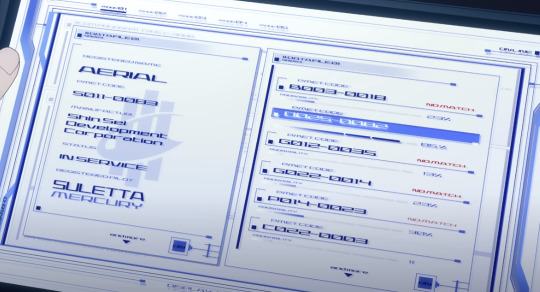
TEXT: (Lefthand side) Registered Name: AERIAL PMET CODE: 5011-0083 MANUFACTUR(ER): SHIN-SEI DEVELOPMENT CORPORATION STATUS: IN SERVICE REGISTERED PILOT: SULETTA MERCURY
At the beginning of the episode, Rouji has Haro run a program that compares Aerial's permet code and registered statistics against other registered Mobile Suits to try and find a match, and measures the probability of the two being the same type of MS. There is no direct match to any other MS by Permet Code, but the system states there's an 85% probability that it's a match for a Mobile Suit with permet code 0025-0082.
We never see the specific name of this MS, but considering that Shaddiq names "Ochs Earth" as the company that made it and proceeds to call Aerial, "...the Witch's Mobile Suit," I think it's reasonable to assume that 0025-0082 was the Permet Code for Lfrith-03.

TEXT: ALERT ACCESS CONTROL [???] [----OF ENTRY A---]
Unfortunately due to the small text of the Alert message, the fact that it scrolls, and it's brief time onscreen, its hard to make out specifically what it says. My best assumption from what we have is that it's a warning currently barring anyone from entry into the 13th Tactical Testing Sector.

TEXT: (Suletta's Asticassia ID) PILOTING DEPARTMENT ID No: LP-041 SULETTA MERCURY BIRTHPLACE: MERCURY HOUSE: NO DATA PC-CRIMINAL RECORD: NO DATA PC-BIOMETRIC SYSTEM: REGISTERED
(Below) WE ARE RESPONSIBLE UNDER COMPANY REGULATIONS FOR THE PROCESSING OF PERSONAL DATA
UNDER THESE REGULATIONS, WE ARE ALSO RESPONSIBLE FOR DATA HANDLING SUCH AS TRANSMISSION TO RECIPIENTS AND THIRD PARTIES.
PLEASE REFER TO THE FOLLOWING DOCUMENTS FOR DETAILS.
As Suletta is being questioned, we get a brief glimpse at the investigation report the interrogator was looking at before the screen cuts to black when it hits the table. Nothing super interesting here, but Suletta doesn't have a registered criminal record! Yippeeee!

TEXT: CAM: 05 MONITORING CAMERA FACILITY MANAGEMENT COMPANY
Not much to say here, this camera lets us know where Suletta is currently being held. (The Facility Management Company)
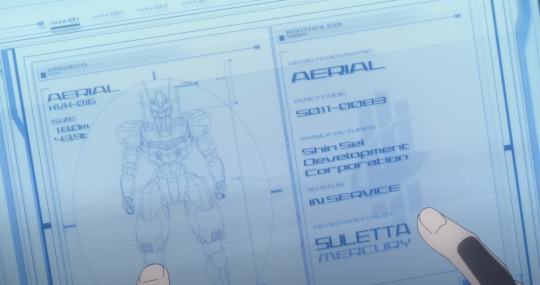
TEXT: (Lefthand Side) AERIAL XVX - 016 SIZE: 18.0m 48.9t
No point discussing the info on the right, we've already seen it, but this gives us a look at Aerial's height and weight.

TEXT: (Top Right) COM DELLING REMBRAN BENERIT GROUP
I only included this to point out that wow the display system devs made some poor choices with the UI here. Dark Blue text on Dark Backgrounds? You'd think the text would automatically lighten but I guess we'll have to wait for Ver 6.0 for that update.
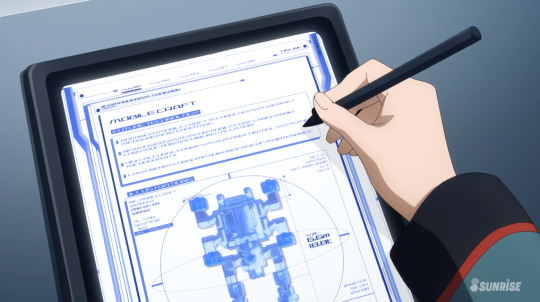
TEXT (Top half) MOBILE CRAFT FUTURE TECHNOLOGY
ADVANCED MOBILE CRAFT TECHNOLOGY WITH PERMET MEASUREMENT EXPERTISE NEW POWER SYSTEM FOR MOBILE CRAFT AND HYBRID CONSTRUCTION MACHINE INSTALLATION HIGH ACCURACY DRIVE SYSTEM AND CONTROL SYSTEM IN MICROGRAVITY LOW ENERGY CONSUMPTION AND EASE OF MAINTENNANCE
No need to discuss the bottom half, its just the height and weight of the MC which we already know. I think it's funny how many classes this school seems to have on the new and improved Mobile Craft from Future Technology. I should probably buy one too. I love you Mobile Craft.
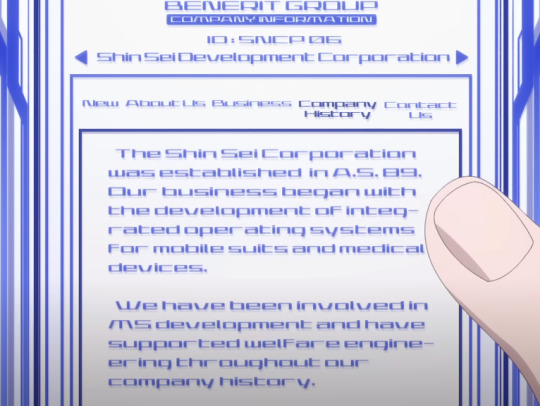
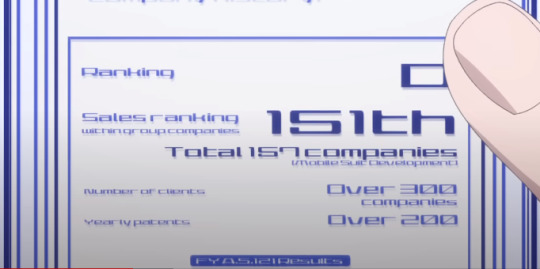
TEXT: (Left Image) The Shin Sei Development Corporation was established in A.S. 89. Our business began with the development of integrated operating systems for mobile suits and medical devices. We have been involved in MS development and have supported welfare engineering throughout our company history.
(Right Image) Ranking: D Sales Ranking (within group companies): 151th (out of) Total 157 companies [Mobile Suit Development] Number of clients: Over 300 companies Yearly patents: Over 200
We get a lot of information about Shin Sei in this scene where Martin looks at the Company History tab on their official website. The most interesting thing being that they were founded in A.S. 89. The Vanadis Incident occured in A.S. 101, and the show proper takes place in A.S. 122, so at some point between 101 and 122, Prospera worked her way up through Shin Sei, eventually becoming its CEO.
Given that Suletta had to have been born around A.S. 105, and that in Cradle Planet, we learn that Prospera had been working within Shin Sei when Suletta was around 6, that places A.S. 111 as the earliest she was involved.
We also learn in Cradle Planet, that when Suletta is around 11, Prospera has recently been promoted within the company, and now has many people working under her. That would be around A.S. 116. When Suletta is 16, that's when Prospera tells her that she's going to school, which would be around A.S. 121, and I think it's safe to assume that she had already become president by then.
SO!! TL;DR!! It's most likely that Prospera became the president of Shin Sei at SOME point between A.S 116 and A.S 121. I'd put it somewhere in the middle, around A.S 119. (Can't wait to find out that they probably just outright state this somewhere and I did all this for nothing....)
ADDENDUM

GOD DAMNIT. I WATCHED ALL OF CRADLE PLANET TO MATH THAT SHIT OUT. WHATEVER. I CAME TO THE SAME CONCLUSION SO I WIN.

The text is too small to make out, but we DO get a small glimpse at the letter Delling sent to Miorine about unenrolling her from the school. It probably just literally says what the body guard reads out.
I think it says something that Delling doesn't even like, text his daughter. He sends an email through the official Benerit Group email account to her bodyguard who reads it for her. What a cowardly man.

TEXT: (Left) FLUSH (Right) EMERGENCY CALL UNLOCK LOCK
YES the toilet text is important to document stop fucking looking at me like that.

TEXT: NEXT STAGE TOUCH SCREEN TO CONTINUE
I'll leave the explanation of the symbolism of this scene as an exercise for the reader. [Sultry Wink]

TEXT (Above) THIS ELECTRONIC SIGNATURE IS PROOF THAT IT WAS SIGNED BY A REPRESENTATIVE OF THE BENERIT GROUP.
No way to tell what Delling is signing here, but we do get a brief look at his handwriting. It turns out his cursive is really bad, actually!
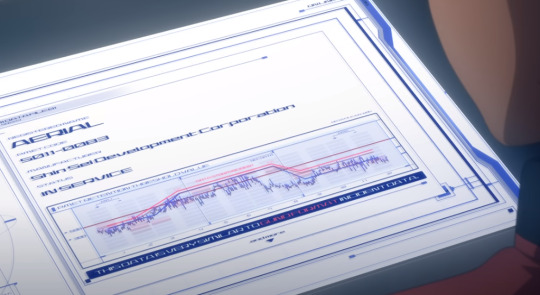
At the Shin Sei inquiry, Shaddiq shares this graph titled "PMET RETENTION THRESHOLD VALUE", stating that during the duel, Aerial's Permet Influx Values exceeded the standards set by Cathedra.

This graph can be tough to parse, so let me explain it as best I can. The blue line represents Aerial's Permet Retention during the duel. The solid dark line represents the permet retention limit imposed by cathedra on mobile suits. (At around 500) As we can see, while Aerial began the duel underneath that limit, it exceeded it for a moment (presumably when Suletta took over for Miorine and the GUND bits were activated.)
The red line above that is labelled DATA STORM INCIDENT, which is representative of the minimum Permet Retention a Gundam expresses when it is interfacing with a Data Storm. The text on the bottom reads, THIS DATA IS VERY SIMILAR TO GUND FORMAT INCIDENT DATA.
But the key thing to take note of here is that Aerial's chart just BARELY doesn't exceed the DATA STORM INCIDENT graph, meaning that, despite it exceeding Cathedra's standards, it CANNOT be directly proven that Aerial was interfacing with a Data Storm. This is actually what Prospera brings up as her main counterpoint to the accusation.

So the graph is entirely consistent with Prospera's main argument. While she can't prove that Aerial isn't a gundam, nobody else can prove that it is.
Huaaaahh!! Alright!! This one was very DENSE. If you made it all the way through, thank you very much!! As a reward, have some little gay people




[I sprinkle these stills on the ground like bird seed.]
There was definitely a lot of really interesting info in this episode, and while not a lot of it was particularly new, I think it's really a testament to the dedication of keeping things wholly consistent in this world, even for the smallest of things that no normal person watching would even bother noticing.
Also, on the Shin Sei Website, did you notice that they accidentally put 151th instead of 151st?
You can't win em all!
Click here to go to Episode 3! >>
Click here to go to the Masterpost!
36 notes
·
View notes
Text
Secure Your Business with CCTV Cameras in Gaya
In today's world, security is paramount, especially for businesses. Whether you run a small shop or a large enterprise, protecting your premises, assets, and employees should be a top priority. One of the most effective ways to enhance security is by installing Closed-Circuit Television (CCTV) cameras. CCTV cameras not only act as a deterrent to potential criminals but also provide valuable evidence in case of any untoward incidents. In Gaya, businesses are increasingly turning to CCTV cameras to safeguard their interests. Let's explore why CCTV cameras are essential for business security in Gaya and how you can benefit from them.

Deterrence of Criminal Activities
CCTV Camera Store in Gaya are an excellent deterrent against criminal activities such as theft, vandalism, and burglary. The mere presence of cameras can discourage potential criminals from targeting your business. Knowing that their actions are being recorded and monitored makes individuals think twice before committing a crime, thereby reducing the likelihood of incidents occurring on your premises.
Enhanced Monitoring and Surveillance
With CCTV cameras installed, you can monitor your business premises in real-time. This allows you to keep an eye on activities inside and outside your establishment, even when you're not physically present. Modern CCTV systems offer remote viewing capabilities, allowing you to access live footage from your smartphone or computer. This feature is particularly useful for business owners who travel frequently or have multiple locations.
Protection of Assets and Inventory
For businesses that deal with valuable assets or inventory, Camera Store In Gaya provide an added layer of protection. In the event of theft or damage, CCTV footage can serve as crucial evidence for insurance claims or police investigations. Additionally, by monitoring your inventory, you can prevent internal theft and ensure that your assets are secure at all times.
Employee Safety and Productivity
CCTV cameras can also contribute to the safety and productivity of your employees. By providing a secure work environment, you can boost employee morale and reduce the risk of workplace accidents or conflicts. Fire Extinguisher Store In Gaya can also help in monitoring employee performance and adherence to company policies, ensuring that everyone is on the same page.
Compliance with Regulations
In many jurisdictions, businesses are required to maintain a certain level of security, including the use of GPS Tracker system In Gaya. By installing CCTV cameras, you can ensure that your business complies with relevant regulations and avoid potential fines or penalties for non-compliance.
Cost-Effective Security Solution
Compared to other security measures, such as hiring security personnel, CCTV cameras offer a cost-effective solution for businesses of all sizes. Once installed, Automatic School bell Store In Gaya require minimal maintenance and can provide round-the-clock surveillance without the need for human intervention.
CCTV cameras are an indispensable tool for enhancing the security of your business in Gaya. By deterring criminal activities, monitoring your premises, protecting your assets, and ensuring employee safety, CCTV cameras offer a comprehensive security solution for businesses of all sizes. If you haven't already installed CCTV cameras in your establishment, now is the time to do so and secure your business against potential threats.
#Top CCTV Installation Services in Gaya#Camera Store In Gaya#CCTV Camera Store in Gaya#GPS Tracker system In Gaya#Fire Alarm Shop In Gaya#Note Currency Counting Machine Shop In Gaya#Automatic School bell Store In Gaya#Epabx and Intercom Store In Gaya#Video Door Phone Store In Gaya#Fire Extinguisher Store In Gaya#Biometric Attendance and Access control In Gaya#cctvinstallation#cctv camera#cctv
1 note
·
View note
Text
Character Bio of the Asian Pasifika demigod and Afro Latine Native alien hybrid main character Part 17
Advanced Next Gen Mecha suit.
Helios, Prometheus, or Oceanus a cardinal, gold, silver, & obsidian advanced next gen series mech suit series. A mecha is a robotic machine, which can vary widely in size, configuration, and purpose. Mecha are usually vehicles controlled from an onboard cockpit by a single, two, or three pilots. The mecha is repaired, customized, & upgraded by a small to large crew of engineers, scientists, & inventors.
The mecha is controlled internally by aircraft or spacecraft pilot controls, voice commands, motion capture, thoughts and emotions with synchronization from the pilot, and with several dumb and simple AI and a few advanced and complex AI assistance from inside the cockpit of the mecha. Mecha cockpits have a single pilot, two pilots, three pilots, or even four pilots depending on the mecha make, model, & series. These mecha are piloted by one pilot.
Sometimes it has a pilot mode that includes a comfortable leather space fighter or aircraft fighter jet piloting seat and space fighter or aircraft fighter jet controls for piloting. For this mode it can have two pilots controlling the mecha suit. These are liked by former space navy or space force pilots.
These pilots enter the mecha while on base or on a spacecraft or capital ship by an elevator or escalator that takes them to a raised platform that is level with the cockpit of the mecha. The pilot then steps into the mecha suit which closes its hatch behind them. The pilot can also enter the mecha if the mecha is already on sight on the battlefield by parachuting into the mecha after a Halo jump or orbital drop insertion. They can also enter the mecha suit by having the onboard ai of the mecha control it and lower its hand to them so they can climb on and climb inside the mecha suit. If the mecha suit is in space they can enter the mecha while in EVA zero gravity by using a jetpack to fly to the mecha cockpit.
Metahuman and superhuman super soldier pilots can perfectly assimilate and synchronize with the mecha suit. The mecha works in tandem with their superhuman and metahuman abilities and physiology. By taking advantage of their super soldier training and powered armored super soldier skills. The mecha suit can enter assimilation or synchronization battle mode with the super soldier pilot for several hours without drawbacks or recoil damage to the pilot.
The mecha is mainly piloted by tracking movements made by the user's body. The pilot when flying the mecha uses a tech suit or body suit. This suit synchronizes and interfaces between the pilot and the mecha. It utilizes a spacious spherical cockpit for full body movement. Made especially for black ops and spec ops super soldiers. It takes full advantage of the abilities of demigod metahumans and superhuman alien hybrids. Pilots essentially become at one with the unit. Acting as the avatar for the mecha's actions and the receptor of any activity to the mecha in return. The pilot also wears a helmet that interfaces and synchronizes their thoughts and emotions with the mecha. Allowing them to command the mecha by their voice as well as conscious and unconscious thoughts and emotions. This is assisted by dumb simple AIs (who are complex and smart by regular human and alien standards) and smart advanced AIs who improve the super soldier pilots' already superhuman abilities and piloting.
Has naturally enhanced and artificially enhanced abilities. Their body and mind reacts on a superhuman level when piloting. This increases their natural skill and control when piloting. The main character can also pilot the mecha by hacking into the human and alien technologies itself with their technopathy as a cyborg/bionic. The mecha is only accessible by the pilot using a fingerprint, eye, & dna biometric scanner. In the event of capture by the enemy it has a self destruct sequence that has the destruction of a high yield nuclear weapon. It overloads the nuclear fusion reactor core.
The mecha is personalized with red, black, white, blue, & green alien and human emblems, decals, & symbols on its face, neck, chest, back, arms, elbows, hands, legs, & knees. The mecha is also decorated with alien and human characters and calligraphy.
Has high firepower. Is heavily armed. Is heavily armored. Has high maneuverability. Has high accuracy. Is highly customized and upgraded. Is regularly repaired, maintained, & updated by a crew of mechanics, scientists, engineers, & inventors. It has a clean, polished, & new paint look maintained by artists. Its symmetry positively affects its balance and makes it easy to control. Its performance is enhanced with their superior piloting skills.
It flies using spacecraft and aircraft rocket thrusters on its back, arms, legs, & feet. The mecha also flies though a pair of robotic wings and a pair of hard light wings built onto the shoulders of the mecha. It glides and hovers using rocket thrusters on its arms, hands, elbows, knees, legs, ankles, & feet of the mecha. It swims using turbines on its chest, back, arms, hands, legs, ankles, & feet. It has a cooling and ventilation system using space craft turbines, aircraft vents, & a liquid nitrogen cooling system to cool and ventilate the mecha to prevent overheating when using rocket thrusters or when using the mechas immense firepower.
They are trained as mech pilots using mock duels, VR simulations, combat drills, combat simulations, physical training, & piloting exercises similar to power armor and spacecraft training. They are also trained using augmented reality using mecha figurines and miniatures as personal avatars. As a mecha operator and pilot they employ advanced knowledge and natural skill.
He/she/they the Asian Pasifika demigod and Afro Latine Native alien hybrid main character since they were a child played with miniatures of powered armored soldiers and models of mecha suits based on media of their world. This was given to them by their geeky mother. This was given to them by their nerdy father. They would use these as avatars in virtual reality and augmented reality simulations to play in championship games, competitions, and contests as a video game streamer against other children, preteens, teenagers, and young adults in next gen console holographic 4d games which was ironic considering their future as super soldiers in powered armor and mechas themselves.
It is powered by nuclear fusion reactors. The main bigger fusion reactors are found in the chest and back of the mech suit. The secondary smaller fusion reactors are found in the head, neck, arms, and legs of the mecha. It is powered by lunar rays, cosmic energy, magical energy, natural energy, spiritual energy, zero point energy, & nuclear power. It can be recharged by steam power, water, wind power, solar radiation, & electric power.
The mecha is armed with anti capital ship weapons such as a gravity gun, a sonic cannon, a positron cannon, a rail gun, a electromagnetic mass accelerator cannon, a antimatter weapon, a mass driver cannon, an ion cannon, a particle beam cannon, & a zero point energy cannon capable of obliterating entire space fleets at maximum output for primary weapons. Each of them are quadruple, triple, or double barreled to reduce and spread out the stress caused by the powerful shot outputs. Has two charging barrels that can be attached to the single, double, triple, or quadruple barrels of the mecha cannons and amplify its power.
Primary weapons with enhanced output. They are big enough to be held by mecha units. They are powerful enough to destroy squadrons of mech units at low output to even fleets of spaceships and capital ships at full power maximum output. The mecha rifles have the ability to adjust the weapon output. At high output, beams are emitted from each barrel to form powerful blasts. Capable of single shot, three round burst, or full auto when firing. The mecha weapons have an excellent rate of fire and a variable output. At low power it can destroy a few mecha suits. Which at maximum power rivals or even exceeds the firepower of capital ships such as a dreadnought, battleship, a battle cruiser, or flagship combined. The interior of the barrels contains alien and human metal parts for superior durability. It is made to withstand the high output of the hand held super weapon.
Their mechas main battle tactic is to destroy enemies from afar with its heavy firepower which has been pushed to the limit. It specializes in close ranged, medium ranged, & long range combat. The cannons have a relatively fast cool down time in between shots. This allows for shots to be fired within seconds or minutes depending on weapon mode. Puts an emphasis in precise targeting in long range combat. Can use frontal assaults that would make full use of their mechas imposing firepower in combat.
It is armed with secondary weaponry. It is armed with laser, energy, plasma, ballistic, & hard light mounted 50 caliber anti tank heavy machine guns in the shoulders of the mecha. It is armed with laser, energy, plasma, ballistic, & hard light anti tank quadruple barrel Gatling Guns on the neck of the mecha. It is armed with anti personnel heavy flame throwers. It is armed with anti personnel light and medium machine guns in the head of the mecha. It is armed with laser, energy, plasma, ballistic, & hard light 40 mm mounted anti aircraft rocket and grenade launchers built into the chest of the mecha. It is armed with laser, energy, plasma, ballistic, & hard light mounted anti spacecraft missile silos built into the chest of the mecha. It is armed with a back mounted ballistic, hard light, & plasma anti spacecraft artillery cannon that fires space navy fleet artillery barrages.
It is armed with two giant handed hard light beam swords, axes, spears, sledgehammers, etc as melee weapons as primary melee weapons. It is armed with giant plasma beam short swords, short axes, plasma warhammers, plasma tonfas, escrima sticks, & plasma knives as secondary weapons. For close ranged combat they also use the speed and maneuverability of their suit.
It is protected by laser, energy, plasma, & hard light shields and force fields. It is protected by ballistic armored plates. It is protected by a ballistic and hard light war door shield mounted on the left arm of the mecha. This protects the mecha while the mecha is aiming with their handheld primary weapon. It also protects the mecha from enemy mech firepower or handheld ranged weaponry or melee close combat weapons.
Mechs are designed by teams of R&D scientists. Mech pilots pilot mecha suits. These mech suit pilots are assisted by teams of mechanics. It is customized, upgraded, repaired, & tested by teams of scientists, inventors, & engineers. It is designed for terrestrial, aquatic, aerial, & space combat. It was designed for combat in arctic, desert, jungle, swamp, or forest terrains. Uses active sonar, a motion sensor, gps system, & radar.
They have Zeus, Jupiter, & Odin series mech suits that they personally call Helios, Prometheus, and Oceanus. It is 200 meters tall. It weighs 80,000 tons. The mecha suit is launched out of a hanger or shuttle bay or spacecraft or capital ships using a catapult deck. The mecha can also enter the battlefield by exiting the cargo door of a space shuttle. It can also be launched using a catapult deck of a spacecraft carrier. While piloting the mecha pilot is wearing a tech suit and a flight helmet and is protected by combat armor and a combat helmet.
The pilot is armed with an hard light assault rifle, a hard light sniper rifle, a hard light combat shotgun, a plasma light machine gun, a plasma submachine gun, & a plasma pistol for emergencies. They are also armed with a hard light sword and plasma combat knife for emergencies.
In emergencies the cockpit is capable of separating from the mecha and turning into a small space fighter for emergency combat and escaping danger. The space fighter is armed with plasma torpedoes and hard light machine guns for protection. In the event of emergencies the pilot is also able to escape by ejecting using the mecha piloting seat and using a parachute.
Mechs are part of an arms race between factions, countries, world governments, alliances, empires, planets, & intergalactic governments. There is mech on mech warfare. Mechs settle territorial disputes and interplanetary conflicts.
You can customize mechs. You can also upgrade mecha units. There are many types of mechs. Such as close combat types, medium range assault types, long range artillery, support types, & command and control types.
You can be a regular soldier in the armed forces as an ensign to captain in the space navy as a mecha pilot. Or you can be a mercenary or private soldier as a mecha pilot selling your services to whoever pays you for the highest bidder. Completing missions as a merc earns you notoriety and fame among mercenary companies.
Mecha are one component of an integrated military force. They are supported by and fighting alongside walking tanks, battle walkers, fighter jet aircraft, and infantry. Mecha are war machines. They are essentially armored fighting vehicles with legs instead of treads or wheels. There are also civilian type mecha that are also used for civilian purposes such as heavy construction work, police functions, or firefighting.
They primarily use mech suits as a freelance mercenary fighting for the space federation. They used to fight for the space federation and Terran hegemony in the space force and space navy as a mecha pilot. They as a mecha pilot used it since they were an ensign to a captain in the space navy. They as a mercenary used it as a commander of a mercenary company. Has fought in many battles. Has been defeated several times by other veteran mecha ace pilots. They have seven rivals as a mecha pilot. Shows apparent gratification over their victories. They have concern for the nature of the mecha battles themselves. Is filled with the emotions that drive the pilots that engage in these mecha fights.
He/she/they have a certain knack for mechanics and inventing including building next gen advanced robots, androids, & synthetics. A talented inventor, engineer, scientist. They even created their own next gen advanced mecha series suits as a scientist, inventor, & engineer. They are a recognized genius and are the principal chief engineer, scientist, & inventor behind the creation of several advanced next gen mecha suit series. Just by looking in the piloting manual for the first time. They have a small robotic droid capable of flying and walking to help them while piloting the mecha suit. They are also the artist behind powered armored soldier miniatures and mecha suit models.
On board the first mecha suit they piloted, an old gen series mecha, he/she/they were able to use and fight with it. In this sortie he/she/they destroyed a few enemy mecha suits at the same time. He/she/they honed their skills and abilities to the point where the mecha suit needed an upgrade and be tuned up to even be able to match up to their immense piloting skill. He/she/they are adept at mecha suit combat in all ranges from close, medium, & long range combat. He/she/they can handle multiple enemies at once. With their exploits in the next gen advanced mecha suit they earned the call signs and codenames Grim Reaper, Metal Demon, Zero, & Nemesis as a mecha pilot.
They possess superb sharpshooting skill and superhuman knowledge with a wide array of firearms. Even before becoming a super soldier, powered armor soldier, & mecha pilot they were known to score high grades in sports marksmanship, archery competitions, and trick shooting championships. They scored a consistent 95% accuracy in vr stimulation battle tests. As a trained sniper, they know about stealth tactics, camouflage, infiltration, assassination, and has an intuitive understanding of trajectory physics for sharpshooting.
They are great battlefield commander. He/she/they uses their skills to lead rookie pilots in several successful missions for training. As a commander they have superb knowledge of coordinating military tactics and have a lot of battlefield intuition. Leads a squad of other ace veteran mecha pilots. Always looking for enemy veteran ace pilots to test their skills against.
They have a strong tactical sense. They know when to show restraint and not pursue an opponent too far. They also show adept perception, awareness, & intelligence. They are able to discern the properties and vulnerabilities of enemy mecha suits from a single observation. From there they are able to execute a counter-strategy.
They are at the peak of their piloting skill even while using an inferior older mecha suit. They critically damaged an advanced next gen mecha suit. They are shown use of pragmatic and clever tactics over their mecha piloting career as a mecha pilot for the federation space navy and as a freelance mercenary for a mercenary company often catching their enemies off guard.
He/she/they have sharp senses and rapid information processing ability. He/she/they have great adaptability in combat. He/she/they have exceptional mecha shooting precision enhanced by their abilities as a super soldier. It became the core of their piloting style.
He/she/they always try to disable the enemy mechas first without lethally harming or killing the mecha pilot by aiming for weapons or body parts. They target the mecha except for the cockpit. Won’t go out of their way to kill enemy pilots. But can if there is no other choice or when there is no other option as a trained soldier. They value life as a person as a personal value but can kill or injure enemies when necessary with their training. They aren’t naive or idealistic but are realistic and have a grounded perception about the reality of war and combat.
As a super soldier with black ops and spec ops military training their fighting ability developed quickly and greatly. As their time in combat as a powered armor soldier and mecha pilot increased. He/she/they are a talented pilot with great drive and focus to better themselves in their piloting skills. Is as a one-man army type mecha pilot being able to hold his/her/their own against several next gen mech suits single-handedly and even forcing them to retreat.
Goes into sorties with enemy mech suits with the support of their mecha squadron. He/she/they is talented and favors close-range combat, medium ranged combat, and long-range combat. This comes in handy due to both of their mecha suit's capabilities to handle any form of combat in any terrain. He/she/they is a very adept pilot capable of piloting any mecha suit. Most so when using their own personal, customized, & upgraded next gen mecha suits.
He/she/they remains focused, collected, calm, and precise when piloting. They are able to perform many difficult flight maneuvers and battle maneuvers in mock duels, VR simulations, augmented reality, physical training, and real combat situations. As a mecha suit pilot they are also excellent and highly skilled.
He/she/they quickly adapts and improvises to sudden changes in environment conditions such as arctic, desert, jungle, forest, swamp, mountain, volcanic, aerial atmospheric combat, or even zero gravity space combat. They also adapt and improvise to sudden changes in opponents' tactics, read their thoughts and movements, and are able to predict their next attack.
They are a skilled fighter who excels in precision. They are capable of dodging volleys of missiles head-on. They are even flying close to them. Almost touching them in flight without setting them off. In mecha suit battles, they are good at high-speed maneuvering honed from their experience piloting aircraft and spacecraft.
Has the capacity to use covers, the environment, or even the terrain to their advantage. Even if all of their weapons have been incapacitated. They will still manage to weaponize the other abilities of their mecha itself as well. As a mecha pilot and operator they have tactical skill and make use of their surroundings, cover, & the environment in combat. They are an experienced officer and extraordinary tactician. He/she/they are also a cunning strategist and tactician. Managing to outsmart many of their enemies, even when they are not piloting a mobile suit.
They use the droid and dumb and simple AIs to analyze the opponent to provide navigational and tactical data during battle while they pilot the mecha suit. These droids also pilot small unmanned drones to fight enemy spacecraft, aircraft, or tanks so the mecha pilot can focus on fighting enemy mecha suits. The droids and dumb AIs also complete tasks for the mecha pilot when they are piloting.
After being unofficially trained by veteran ace pilots Fumiyoko Sakagawa a metahuman ace mecha pilot of the space navy and her wife Kira Nova a superhuman alien ace of the Andromeda Empire space force they honed their piloting skills.
Before becoming a full-fledged pilot they had undergone official training at the military mecha piloting academy. It was there that they showed natural talent as a mecha pilot ranking 1st in mecha suit piloting. Their bold leadership style and leadership skills which they are well known for was developed at the military mecha piloting academy. They had natural experience as a pilot and high scores at the academy. As a mecha pilot they are very mindful of their situation. They are always aware of the status of both their opponent's mecha and their own mecha.
By manipulating space particles, it can alter and absorb enemy cannon attacks through the shields, forcefield, & arm mounted shield. Has a ballistic and hard light war door shield mounted on the mechas left arm that has the ability to absorb and nullify mecha cannon weaponry. The absorbed space particles can be used later. When deployed a spherical hard light, plasma, laser, energy shield and spherical forcefield, capable of absorbing enemy mecha cannon attacks, surrounds the mecha suit. It then redirects and doubles the attacks back at the enemies. Uses a system where space particles permeate its mecha frame increasing its output at an accelerated rate.
They have an ability to perfectly synchronize with their mecha suits. They, as a bionic and cyborg, communicate directly with the AIs of the mecha and the mecha itself directly when piloting. Super soldier pilots unifies their senses with the mecha itself. A drawback is the endurance and stamina of the pilot is consumed and needs to be recovered. Takes advantage of their knowledge of human, alien, & divine hand to hand and melee martial arts. Uses the output of the mecha to deliver devastating opening moves and devastating finishing moves on enemy mecha suits. Uses space particle emissions to triple mecha suit stats and abilities. This also boosted their fighting abilities by 120% and made them virtually unstoppable.
The mecha suit is installed with a system to maximize its space particle emission. The transparent sapphire, amethyst, crimson, gold, & emerald parts are for storing particles for later emission. More of them are hidden below the armor. Normally, these particles are used for enhancing the mechas close combat, medium range, and long ranged attacks. When they assimilate with the mecha suit its performance improves by more than five times. When activated the parts blaze gold, silver, crimson, & sapphire with celestial, stellar, primordial, & cosmic elemental powers. All the particles stored in the suit can be released at once causing the entire mecha suit to be engulfed in cosmic, primordial, & divine flames, lightning, wind, & ice.
The mecha suit customized, upgraded and updated many times to go from worthless, common, uncommon, unique, exotic, rare, epic, legendary, arcane, mythical, blessed, & even divine rarity.
#indigenous#indigenous artist#indigenous writer#indigenous art#indigenous creator#indigenous rep#indigenous character#native artist#native art#native writer#native rep#native character#native tag#queer creator#queer character#queer representation#queer writer#queer artist#trans artist#trans character#trans representation#trans writer#trans creator#disabled creator#disabled writer#disabled representation#disabled character#disabled art#disabled artist
2 notes
·
View notes
Text
ZKTeco Horus E1-FP Time Attendance Machine
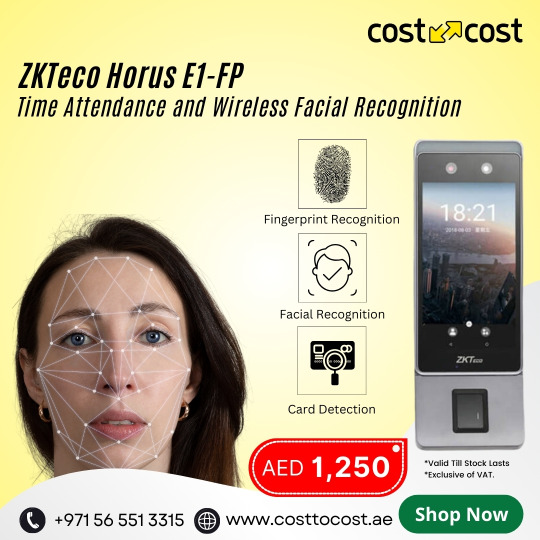
ZKTeco Horus E1FP is one of the most advanced Access Control & time and attendance terminals existing in the market, with an incredibly compact size (almost the same size as the iPhone XS max).
Powerful facial recognition technology offering up to 3 meters recognition distance, ±30 degrees pose angle tolerance, high anti-spoof ability, support on plentiful communication protocols (Wi-Fi, 3G, 4G, Bluetooth) and worldwide network setting, optional fingerprint and RFID card modules, up to 10,000 facial templates capacity.
It is compatible with the all-in-one security & time attendance platform ZKBioSecurity and BioTime.
Functions:
• New height of facial recognition template capacity up to 1: N-10,000 facial templates • Anti-spoofing algorithm against print attacks (laser, color, and B / W photos), video attacks, and 3D mask attack • Supports multiple communication protocols: 4G, Wi-Fi, Bluetooth, and USB • 5-inch smartphone-grade IPS touch LCD monitor • Extensive Fingerprint, RFID, and TCP / IP, modules available • Extra-large 2MP CMOS with WDR function • Various further development options: embedded GPS / A-GPS, microphone, and PIR sensor
Costtocost offers the best price for the ZKTeco Horus E1-FP Time Attendance Machine. Buy now with the best price!
#uae#dubai#it solutions#costtocost#electronics#best electronics and it supplier in uae#it support#it support in dubai#business#zk#zkteco#zkteco horus E1FP#Time Attendance Machine#time & attendance system#fingerprint time attendance machine#biometric time attendance#zkteco horus#onlineshopping#dubai shopping#deals#sale#black friday sale#access control systems
0 notes